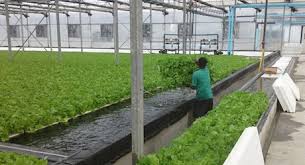Deep Water Cultivation Systems

Deep water cultivation can scale up to enormous size, with vast reservoirs and literally tons of daily crop production. These operations must be planned and managed very carefully, with heavy reliance upon either hired staff and/or automated systems. image courtesy of www.hortidaily.com.
You are on Page 5 of our six page series on deep water cultivation systems. Click on any of the below pages to jump to that page.
Page 1 Page 2 Page 3 Page 4 Page 5 Page 6
Scaleability
Scaleability is one of the big weaknesses of the deep water culture system. As we briefly discussed at the start of this section, changing a DWC system involves changing either the reservoir size or how much of the reservoir’s surface area is in use. Let’s take a closer look at both increasing and decreasing DWC systems.
Of the two options (getting larger or getting smaller), getting larger is by far the more challenging scenario. Almost by definition, a DWC system is already using most if not all of the reservoir’s available surface area. Granted, hobbyist systems which consist of rubber or plastic tubs covered with Styrofoam can relatively easily just get more tubs and Styrofoam. However, optimized commercial operations are another thing altogether. Expanding an already optimized commercial system usually requires building additional, often sizeable, new reservoir space. Commercial operations which are doing well and thinking about expanding, must therefore carefully consider how much to expand, and whether their new markets and/or higher demands truly warrant construction of a whole new reservoir. Even if the answer is yes, that operation will have to go through all the same calculations about expected production volumes, new construction costs, anticipated reservoir size and resulting changes to the operation’s bottom line.
Operations which want to cut back on production have an easier task. Such an operation can always leave unplanted rafts on the reservoir, thus reducing production without actually reducing size. This may result in higher costs per plant, which might boost the crop price. However, there are some benefits. Nutrient solution won’t have to be cycled as often, which will reduce costs, and manpower or automated systems can be cut back as well. As with many other facets of hydroponic operation, growers are well advised to carefully consider their options before making drastic changes in operational size. While it might seem that I’m beating an issue to death, this is yet another reason to carefully consider an operation’s size before building anything. Changes like this can take a profitable operation down into failure if it’s not done carefully.
Can Crops Be Germinated In This System?
The short answer is no. As we’ve already discussed, deep water culture usually features well-rooted young seedlings being transplanted into the system, when the roots are long enough to reach into the reservoir. For those growers who are determined to use this system to germinate their seeds, that requires that they use very fine-size growing media in fiber pots, and that the pots themselves extend into the reservoir. This is the only way that moisture will wick up into the rest of the growing media such that the seedling will germinate. That, in turn, can create such humid conditions that growers have a lot of issues with damping off disease, which can cut down an entire planting while it’s only a few days or weeks old. Additionally, many seedlings have different ideal temperatures than mature plants. If that’s the case, and if the grower is raising different ages of plant in the same reservoir, then the reservoir temperature may not be conducive to germination. Given those issues, most growers opt to germinate their seedlings elsewhere and then transplant into DWC once the roots are long enough.
Can Crops Be Transplanted In This System?
Yes. Not only can crops be transplanted, the entire system depends on them being transplanted. Since we’ve already covered most of this issue in the previous paragraph, we won’t belabor the point here. The only additional thing we’ll say is that DWC generally assumes that all transplants will be at the seedling stage. While older plants could conceivably be transplanted into a deep water culture system, it’s not a common practice. There is a rule of thumb amongst growers that plants raised in soil should stay in soil, and those plants raised in hydroponics should stay in hydroponics. For growers who want to move a mature plant from one hydropnics system to another, that could work as long as the roots are long enough to dangle into the reservoir, and as long as the plant itself is growing in (or can be moved to) a net pot or other container which can be securely held in place by the raft.
Back Next
You are on Page 5 of our six page series on deep water cultivation systems. Click on any of the below pages to jump to that page.
Page 1 Page 2 Page 3 Page 4 Page 5 Page 6